Serbian Monasteries Listed as Cultural Heritage by UNESCO















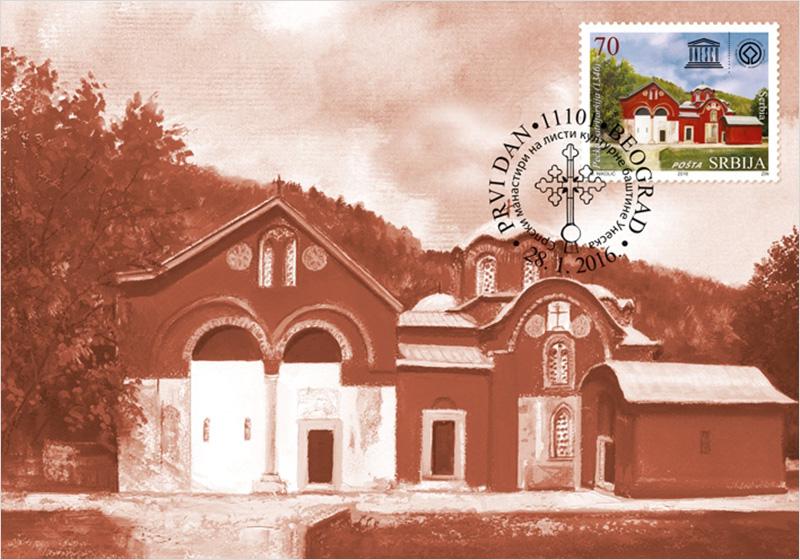

Mother of God Ljeviška is a church in Prizren, the endowment of king Milutin. It was built from 1306 – 1307 on the remains of a cathedral from 13th century, which was also founded on the site of an older early Christian church. The church is a historic seat of the bishop of Prizren of the Serbian orthodox church. The original construction from 13th century was a three - nave basilica. It had three apses on the east side and a narthex on the west side, in front of which there was a porch.
The church is a historic seat of the bishop of Prizren of the Serbian orthodox church. The original construction from 13th century was a three - nave basilica. It had three apses on the east side and a narthex on the west side, in front of which there was a porch. Having been reconstructed in 14th century, the main nave was turned into a five – dome whole, and the side naves were turned into an ambulatorium. This is an idea which had been already seen at the Church of the Apostles of Thessaloniki: the basis is an inscribed cross with five domes, surounded on three sides by a wide nave. Instead of the porch, a two – storey exonarthex (outside narthex) with a bell tower was built. Side walls were taken from the old church. The central dome lies on four pillars, while the small ones are placed diagonally. The church was built of alternately placed rows of bricks and limestone. The exterior is revived by double and triple windows and niches. The oldest preserved frescoes in the church originate from the third decade of the 13th century. These are scenes of the Wedding at Cana, the Healing of the Blind and the Mother of God Eleusa with Christ the Bread – giver. Today, the first two of them are preserved at the Fresco Gallery of the National Museum in Belgrade, while the third is preserved on the southern pillar of the southern nave of the church. The other frescoes at the Mother of God Ljeviška church are the cycles of great festivals, miracles and parables, as well as the portraits of saints and Serbian historic personalities (Stefan Nemanja, Saint Sava, king Milutin).
It was placed on UNESCO’s World Heritage List in 2006.
Gračanica Monastery is the endowment of king Milutin, his wife Simonida and their son Stefan, built in 1321 and dedicated to the Dormition. The monastery is in the village of Gračanica, 10 km away from Priština. The church of the Gračanica monastery is a construction of five domes having an inscribed – cross basis, and as such belongs to the group of first – class architectural realization of that era. The outside narthex was built at the end of 14th century at the time of Prince Lazar. The period of 14th and 15th century was a period of great spiritual glory of the monastery where hundreds of monks developed very intensive spiritual and artistic activities.
In mid 16th century the monastery had the first printing shop. Later, due to great Turkish oppression, the monastery was deserted and the church was used for the parish purposes. After the World War II, the monastery was renewed by the nuns and it has been a convent ever since.
Today, about 20 nuns who live there deal with icon painting, sewing, agriculture and other monastic obediences. Gračanica is one of the most important monuments of the old Serbian culture. The church is built of hewn stone laid in a pattern of double and triple rows of bricks and has five domes and three apses. It is constructed as an aesthetic, constructional and architectural perfection and is of very harmonious proportions. There are frescoes at the church which represent ancestry of the Nemanjić dinasty (a copy from the Dečani monastery), images of king Milutin and queen Simonida, the daughter of the Byzantine emperor Andronicus II; in the central dome there are frescoes of Christ Pantocrator, the Heavenly Liturgy, prophets and evangelists; the Festival Cycle, the Passion, miracles, stories, the Nativity and the Resurrection of Christ, as well as the scenes from the life of the Mother of God, Saint Nicholas and the Calendar of Saints.
It was placed on UNESCO’s World Heritage List in 2006.
Visoki Dečani Monastery, dedicated to Christ Pantocrator and the Ascension of Our Lord, it is an endowment of king Stefan III Dečanski and emperor Dušan. It is placed south – west of Peć, at the foot of the Prokletije mountain.
The construction of the church of Christ Pantocrator began in 1327 by endowment of the Serbian king Stefan Uroš III Dečanski, and after his death the endowment was taken over by his son, emperor Dušan, during whose reign the construction of the monastery was finished, in 1335. The main architect was fra Vita from Kotor, and the monastery, which got its name Visoki (’Tall’) due to unusual proportions for that period (36 metres long and 30 metres tall), was painted from 1347 – 1348 and represents the biggest Serbian medieval monument. With its constructional complexity it represents a harmonious permeation of the western elements – Romanesque and Gothic, and the eastern – Byzantine style with the already existing tradition of the Serbian art.
It was placed on UNESCO’s World Heritage List in 2004.
Patriarchate of Peć – one of the most important monuments of the Serbian culture is the monastery of the Patriarchate of Peć, which is, as a church complex, near Peć. It consits of the church of Holy Apostles, built around 1250, the church of St. Demetrius, built around 1320, the temple of the Virgin Hodegitria and the church of St. Nicholas both built around 1330. From its construction in XIII century, the church was a seat to the Serbian patriarchs, but also the meeting place of learned people and gifted artists. It is believed that the construction of the church of Holy Apostles was designed and commenced by St. Sava, the abbot of Studenica monastery and the first archbishop of the Serbian autocephalous Orthodox church. Today, Patriarchate of Peć is not only an old center of the Serbian church, but aslo an important part of the Serbian spirituality and the place which cherishes great Serbian historic and artistic heritage.
It was placed on UNESCO’s World Heritage List in 2006.
Artistic realization of the stamps: Miroslav Nikolić
Lunar Horoscope – Year of the monkey

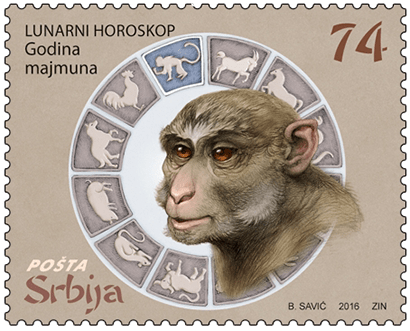




Chinese astrology is based on the traditional astronomy and calendars. It also has a close relation with Chinese philosophy (theory of the three harmony, heaven, earth and water) and principles: the wu xing teachings, yin and yang, five planets, the 10 Celestial stems, the 12 Earthly branches, the lunisolar calendar, etc.
Lunar calendar is based on the cycles of moon phases. Most of these calendars represent lunisolar calendars. That means that calendar months correspond to the lunar cycles, but intercalary months are occasionally added in order to harmonize these cycles with solar years. Among these calendars are Chinese, Hebrew and Hindu calendars, and most calendar systems used in the Ancient World. Lunar calendar differs in its first day of the month. In the Chinese calendar, the first day is astronomically determined by the conjunction of the Sun and the Moon in the Chinese time zone.
The Chinese horoscope falls into the oldest known horoscopes. It consists of 12 signs of which each one rules over a lunar year. These Zodiac signs have the names of animals (Rat, Ox, Tiger, Rabbit, Dragon, Snake, Horse, Sheep, Monkey, Rooster, Dog and Wild Boar). In the Chinese horoscope, besides basic signs, very important are also elements: Wood, Metal, Water, Fire and Earth. Every person born in the year of the assigned animal is said to have personalities and traits resembling that animal.
In 2016, Year of the Monkey starts on February 8th. Previous years in the sign of monkey were 1920, 1932, 1944, 1956, 1968, 1980, 1992, 2004. The monkey is ninth in the Chinese horoscope and it is a sign with a lot of positive characteristics: ingenuity, curiosity, cheerfulness and playfulness. Persons belonging to this sign are very social, like fast life, in which they enjoy. They are fortunate and cheerful in life. They are intelligent and analytical and can reverse every situation in their own favour. Their spontaneity is often irresistible. They are very communica-tive and flexible and like to stand out. However, one should not expect loyalty from them unless they have some interest in it. Besides being insightful, imaginative, ingenious, resourceful, versatile and humorous, people born under this sign can also be cunning, mischievous, shifty, manipulative, insidious and superficial.
Artistic realization of the stamps: Boban Savić, М.А, academic painter.
125th Anniversary of the Serbian Geological Society




Serbian Geological Society is one of our oldest scientific organizations and the first geologists’ society in the Balkans. At the time of its creation, there were only two more “learned societies” in Serbia – Serbian Medical Society and Serbian Archeological Society. In the premises of the Belgrade Higher School, on 23 February 1891 a meeting was held when the participants decided to found a society with the primary task “to perform geological investigations of Serbia and other countries of the Balkan Peninsula and to inform its members and other interested parties about the achievement in the field of geology and affiliated sciences.” The name of the society was given by Sima Lozanić, a professor of chemistry at the Belgrade Higher School during his lectures in Germany. The members of the Serbian Geological Society were many great scientists and explorers, who left an important mark in Serbian and world science: Jovan Žujović (the founder of the Society, minister in several governments, rector of the Higher School, president of the Serbian Royal Academy), Jovan Cvijić (president of the Serbian Royal Academy), Sava Urošević (rector of the Higher School), Milutin Milanković (world authority in the field of climate and celestial mechanics), Vladimir Laskarev (one of the most eminent European geologists). Many initiatives were taken at the Serbian Geological Society and one of the most important was a systemytic geological mapping of our country, the result of which was the Basic Geological Map of the entire territory of the ex – Yugoslavia, completed in the 1970s. Seismological Institute, Museum of Natural History, Geological Institute in Belgrade, as well as other scientific societies in Serbia were founded at the initiative of the Society’s members.
In its history, the Society has become an active member of many international organizations where the views of geologists and geology of Serbia are supported: International Union of Geological Sciences, Association of European Geological Societies, European Federation of Geologists and Carpathian Balkan Geological Association.
Motif on stamp: portrait of Jovan Žujović (painting by Uroš Predić) and Captain Misha’s Edifice.
Graphic realization of the stamp: Jakša Vlahović, academic graphic artist.
Expert collaboration: Prof. Dr. Zoran Stevanović, President of the Serbian Geological Society.
Easter


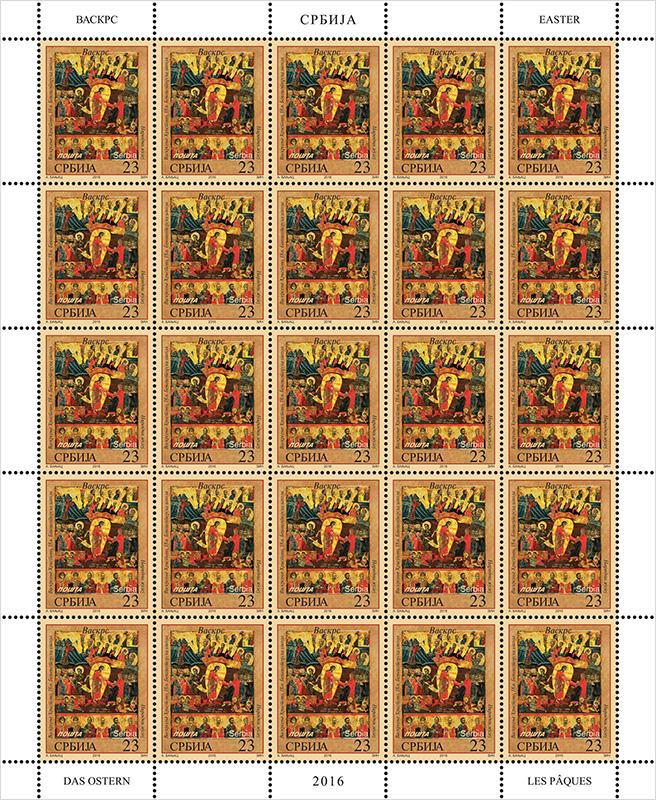


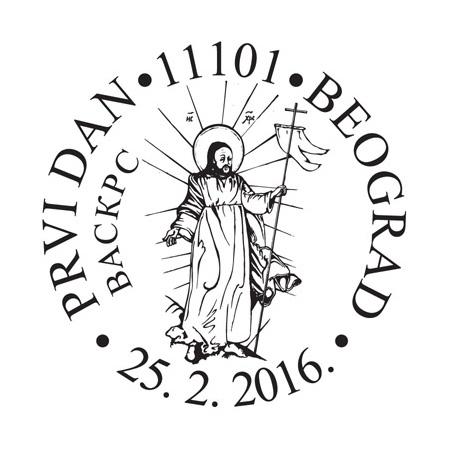
Easter Sunday is the date of the annual celebration of Christ’s resurrection. The Orthodox Church celebrates the Easter on the basis of the Julian calendar. The date is not fixed, but denotes the same season of the year and the same relationship to the preceding astronomical full moon that occurred at the time of His resurrection in 30 A.D.
Easter is one of the most important Christian holidays. This is a day of eternal joy, the day when Christ, the Son of God, conquered the death. By the act of resurrection Jesus Christ proved his divine power and opened the gate of eternal life, joy and happiness that we can find in our faith. On Easter Sunday morning the church bells toll, and the people, together with their priest, go around the church. After the third round they stand in front of the church door. The priest carries the cross, candle and the censer and chants the Easter hymn. The door open and they enter the church where liturgy continues. When it ends, people greet each other with the words: “The Christ has resurrected”, and “Indeed he has”. There are many customs connected with Easter Sunday, and certainly one of them that children like best, is colouring and offering of eggs. The first egg is coloured red and in many parts of our country it is called “The house keeper” and is kept for the whole year, until the next Easter.
Motif on the stamp of nominal value 23,00 RSD: Icon “Resurrection of Christ”, 18th century, Boka Kotorska school of icon painting, the National Museum in Belgrade. The motif on the stamp 74,00 din: the icon “Resurrection of Christ”, 19th century, Vojvodina (?) National Museum in Belgrade. The motif on the envelope: “Descent into Hell”, embroidery, silk, the end of the 14th century, National Museum in Belgrade.
Graphic realization of the stamps: Anamari Banjac, academic painter.
Expert collaboration: National Museum in Belgrade.
Protected animal species




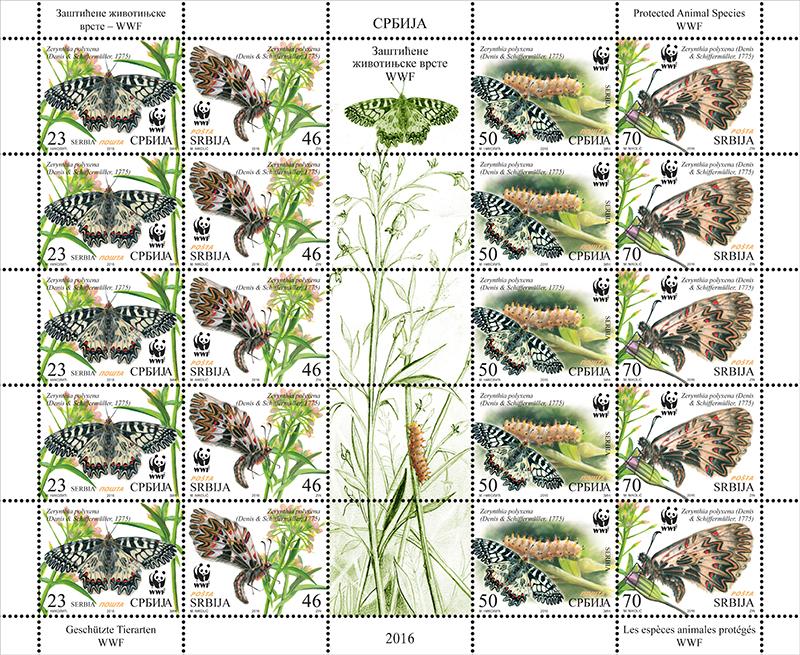
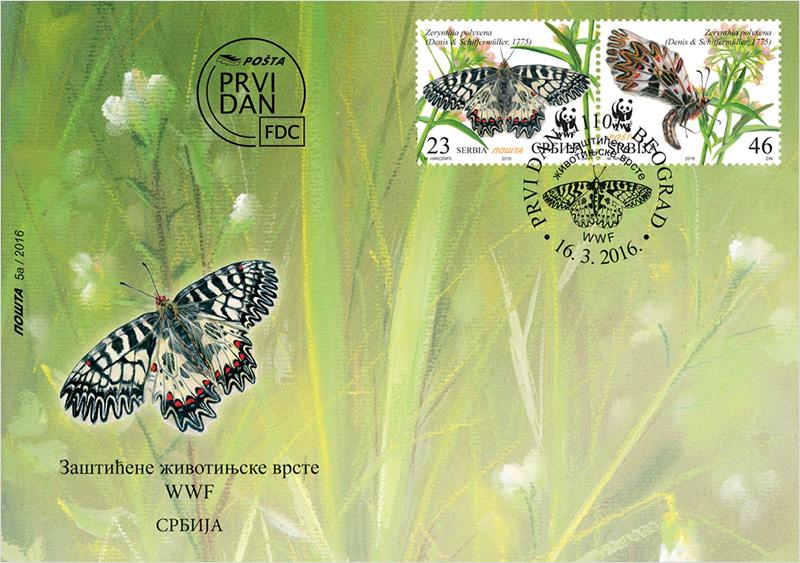


Zerynthia polyxena (Denis & Schiffermüller, 1775), Southern Fastoon is a thermophilous species that belongs to Papilionidae family. Butterflies have a wingspan of 45 do 55 mm. Males and females have similar pattern, but females are bigger and usually have lighter colours. It is widespread but still local, in Central and South Europe, in the Balkans, and in the east it reaches the Urals and Kazakhstan. Big number of subspecies and forms of Southern Fastoon has been described, as a result of its high variability, thus twelve subspecies have been found only in the Balkans, two in Serbia. It inhabits warm and dry steppes or forest steppes, rough stony areas and desolate plateaus, rims of lowland forests, slopes of duns and railways mostly below 900 meters of sea-level. It is Ponto-Mediterranean fauna element.
There is one generation a year. Butterflies are active up to three weeks and their flight-time is in April and May. Females lay about fifty eggs, singly or in small groups, at host-plants. During May and June caterpillars feed only on plants from the family Arystolochia – birthwort, where a large number of them can often be seen. The young caterpillars feed at first on flowers and young shoots, while after the second moult they feed on leaves. Adult caterpillars are long up to 35 mm. Pupae is formed on the stems of host plants. It hibernates as a pupa, and in April next year a new generation of butterflies is hatched. In Serbia it is on the list of strictly protected species, it is included in European Red List of Globally Threatened Animals and Plants and Red Data Book of European Butterflies (Rhopalocera) of Council of Europe where it is treated as vulnerable species. Zerynthia polyxena is threatened primarily by global environmental pollution, excessive use of insecticides, converting uncultivated into arable land as well as by burning of dry grass and other plants where their pupae are wintering.
Artistic realization of the stamps: Miroslav Nikolić
Expert cooperation: Aleksandar Stojanović, Conservator – Entomologist of the Natural History Museum in Belgrade
Science




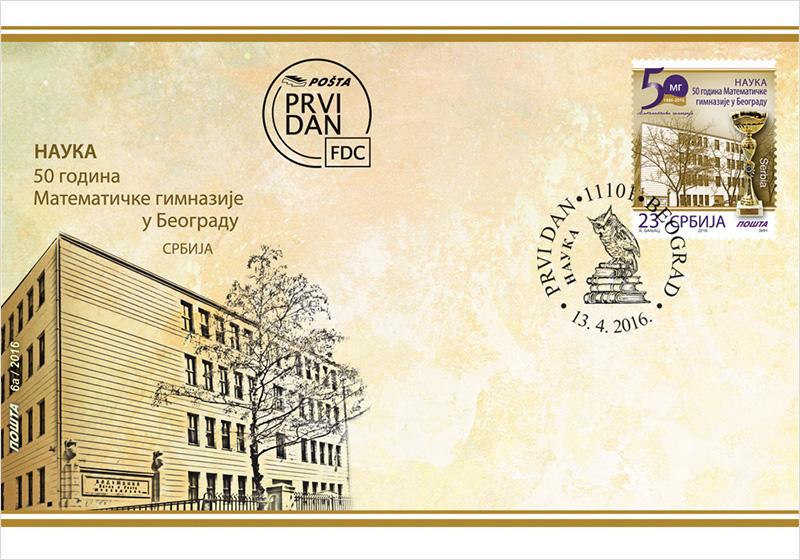
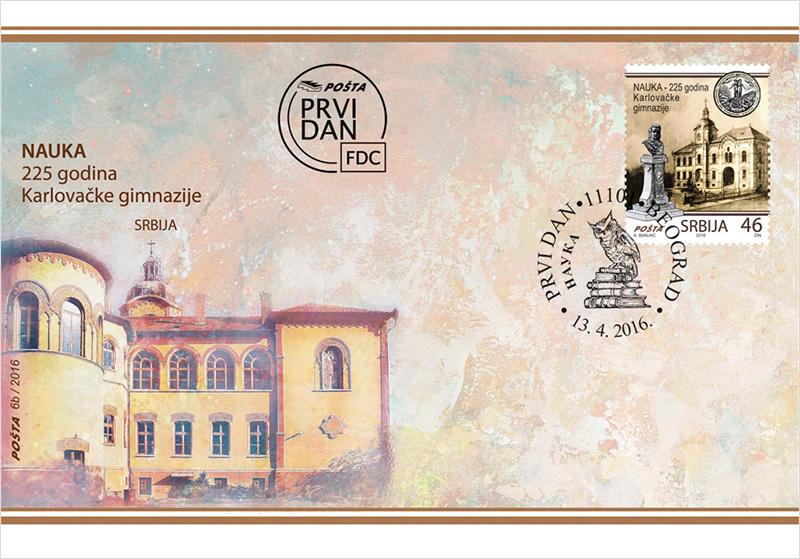

50 years of Mathematical Grammar School in Belgrade – a school of high national distinction
Mathematical Grammar School is a unique school in Serbia for students talented in mathematics, natural and computer science. It was established in 1966, and in 2004/2005 it was extended to include the two final grades of primary school. During 50 year old history, Mathematical School became leading national educational institution, known world wide.
During five decades, around 7.000 students have attended the School. Now 250 former students have a PhD degree and about 400 an MSc, many of whom have received professorships at the eminent universities worldwide, or become world leading experts.
The Mathematical School’s high reputation and affirmation has been won by the successes of its students achieved in school, college and in mathematics, physics, computer science, chemistry, astronomy and astrophysics competitions. The results accomplished are unique in the world. At International and Balkan Mathematical Olympiads, students of Mathematical School have won 456 medals (52 gold, 168 silver and 236 bronze), 57 praise and one special award.
The School has been granted a number of outstanding prizes, including the Dositei’s Prize, St. Sava Award and the National Vuk Karadzic Prize. Students and stuff of the Mathematical School were declared as “Best Belgraders“ for year 2010, and in 2011, they received an award from the European movement in Serbia for the contribution to Europe. Principal of the Mathematical Grammar School, Srdjan Ognjanovic was awarded Manager of the Year 2011 for investing in education.
The Mathematical School also received the “Best European in Serbia” Award for 2014 in the field of education, and was also voted a “Lifestyle Team for 2015“ as an institution that stands out with its authentic and positive attitude towards life and work which should be a role model for young people.
In 2007, Government of the Republic of Serbia proclaimed Mathematical Grammar School as a school of high national distinction.
Artistic realization of the stamp: Anamari Banjac, academic painter.
Expert collaboration: Mathematical Grammar School in Belgrade.
225 anniversary of the Gymnasium in Sremski Karlovci
A wise man, archbishop Stefan Stratimirović exploited the moment of favourable disposition of Emperor Leopold II towards the Serbs in the Austro-Hungarian Empire of that time, and made the long-time wish of the Serbian people for foundation of the gymnasium in Karlovci brought to life in 1791. Stratimirović was the supreme patron of the Gymnasium, and the four members of the Patronage: J. Rajić, S. Avakumović, Dr J. Živković and P. Marković - made the Advisory Council. The seal of the first gymnasium among the Serbs ever, displays two muses as symbols of the science and poetry awaken, above them the ignorance disperses into a cloud, the enlightenment rises like Sun, appears on the right hand side and the vineyards in Sremski Karlovci on the left, braided with a cord with Latin inscription: The gifts to the science ennoble human dignity - allusion to Dimitrije Anastasijević Sabov, the philanthropist. The year 1791 - as the year of foundation of the Gymnasium in Sremski Karlovci - is inscribed at the bottom of the seal. The theatre is the school where people learn, says Jovan Sterija Popović, the founding father of the Serbian drama, bibliophile and a lover of theatre, taking the love from the very essence of the Gymnasium in Sremski Karlovci; Branko Radičević, the most-loved student of all and the most delicate lyric soul of the Serbian poetry is the creator of the famous Student Parting and Sorrow and Reminder. Jovan Rajić, a patron of the Gymnasium, said that “The history of schools does not make a whole cultural history, but without the history of “learned affairs” every cultural history would be without foundations”. Rajić studied the Slavic-Latin Schools in Sremski Karlovci, was instructed by Manuilo Kozačinski (1734-1736) and acted, as a student, in Tragicomedy - the very first drama, the very first performance, in the very first theatre among Serbs. The ending of the Tragicomedy celebrates the scholastic sciences: Analogy, Infima, Grammar, Syntaxis, Poesis, Rhetoric. All these disciplines - grammatical and classes humanitatis - are still being studied at the Gymnasium in Sremski Karlovci.
Artistic realization of the stamp: Anamari Banjac, academic painter.
Expert collaboration: Prof Jelena Ratkov Kvočka, Dr Sc, Gymnasium in Sremski Karlovci.
Fauna

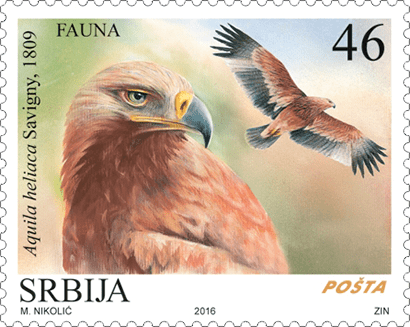
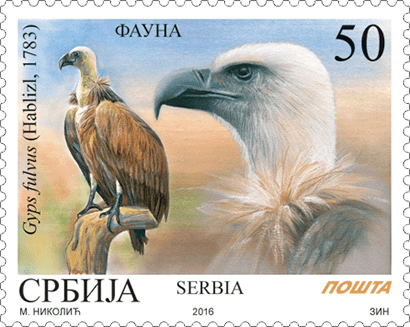





The European beaver Castor fiber L., 1758
The remains from numerous archeological sites testify about the former presence of beavers in the territory of Serbia. In the mid 1800s beavers were already rarely found in the Balcans. High quality fur, delicious meat and castoreum (secretion from a pair of anal glands which was used as a medicine) are the reasons for the disappearance of this species. Today, beavers have the status of an almost endangered species in Europe. In Serbia, they are under strict and permanent legal protection from hunting. During 2004 and 2005 there was a reintroduction of this species in our country, so beavers were distributed several times in the area of the Special natural reserve Zasavica and Obedska bara. Today the population of beavers is on the rise and is significantly spreading. These biggest European rodents are completely adjusted to the amphibious way of life. They move easier and faster in water than on land and they can dive up to 15 minutes. They have stocky body and thick fur with rich hair, flat tail grown in horny scales, and they have a web between the toes of the back feet. Beavers live in families. They dig underground holes, and they build dams on watercoursers which can sometimes be of impressive dimensions.
The Eastern imperial eagle Aquila heliaca Savigny, 1809
The eastern imperial eagles inhabit southeastern Europe, Asia Minor and central Asia. They dwell in Serbia from February to October. They live in open habitats on single trees and alleys, but also accept agricultural areas, very often in the vicinity of human settlements, if they are not hunted. They feed on ground squirrels, but also hunt birds and reptiles. In Serbia, they nest in Vojvodina, where several couples are still successfully self-perserved on mount Fruška Gora. They place their nests in deciduous trees and lay their eggs during the month of March with the incubation lasting 43 days. The number of the eastern imperial eagles drastically dropped in the 20th century, due to degradation of inhabitats and the disappearance of the main prey – the ground squirrel, the use of pesticides in agriculture, hunting, killing and poisoning. The number of the nesting couples in Europe is estimated to be less than 2,500, which is why they are considered to be an endangered species according to the criteria of the European need for protection, and they belong to strictly protected species in Serbia.
The Griffon vulture Gyps fulvus (Hablizl, 1783)
The griffon vulture is the only one, of four species of vultures, which nests in Serbia nowadys and it lives across southern Europe, Asia and northern part of Africa. It has a wingspan up to 2.8 metres and is a powerful flyer which soars very skillfully through warm air above plateaus and vast highlands in search for food – dead animals. Griffon vultures rarely hunt for a live prey, only the sick and weak animals. They nest in colonies, on cliffs and rocks, at an altitude of 500 – 1200 metres. Male and female mate for life, and they use one nest for years. The female lays an egg in February, and the incubation lasts for 52 days. The young are taken care of by both parents. In early 1900s in Serbia, this bird nested on numerous locations, and today it nests in the gorges of the rivers Uvac, Trešnjica and Mileševka, first of all thanks to the feeding places which were formed here in 1989. According to the criteria of the European need for protection the griffon vulture is an endangered species and it belongs to the strictly protected species in Serbia. About 120 couples nest in the three mentioned colonies, while the total population consists of 450 individuals.
The European otter Lutra lutra (L., 1758)
Although the European otter was widely distributed across Europe long ago, it marked a drastic decline in number in the 1960s and 1970s. The reasons for it are poisonous chemicals, destruction of habitats and uncontrollable hunting. The otter is almost an endangered species in Europe, and the most numerous populations today live in southern and eastern Europe. In Serbia, otters are under strict legal protection from hunting, so there is a stable and sufficient number of them. They returned to their old habitats rapidly, even to those which were polluted, such as the Ibar river. Although it was belived that otters almost entirely live near fast, clear mountain streams and small rivers, it was determined that they also live in great rivers of plains and that their presence depends, first of all, on food abundance and availability. Otters live in moist habitats, regardless of altitude. They used to be hunted for fur and sport, and today the mortality factors of otters are: getting hit by cars, poaching, as well as drowning due to entagling into fishing nets and falling into fish traps.
Artistic realization of the stamps: Miroslav Nikolić. Expert collaboration: Milan Paunović, museum counsellor and Marko Raković, curator, Natural History Museum in Belgrade.
Europa – think green






Ecology in Europe
Tradition is a set of values which represent a bond between past and present, and the pledge for the future. One nation cannot fully understand its own tradition and culture unless it connects with other nations. In 2016, the Association of European public postal opera-tors “PostEurop“ is celebrating 60 years since the creation of the first “Europa“ issue postal stamp, and it also reflects on the bridge that is behind us, bridge that European nations and their postal operators have been building continuously for previous 60 years, which is connecting diversity of all parts of Europe and thus creates unbreakable bond between European nations that lasts to this day and which represents one of the greatest achievements of European civilization.
The beginning of this nice and long tradition is placed in 1956 when the first “Europa“ issue postal stamp was realised. Its designer, Frenchman Daniel Gonzague, showed creation of a new Europe destroyed by World War II, which is reflected in building a tower that represents vertically paced letters of the word EUROPA. The tower is surrounded by construction scaffoldings symbolizing that the construction of the new Europe is in progress. Today, 60 years later, when the wars are behind us and when the tower “Europa“ has been built, “PostEurop” recognizes the importance of preservation and protection of the environment, and it selected “Ecology in Europe – Think Green“ as the theme for the 2016, to highlight one of the biggest problems of modern society. Author of the artistic solution for the joint “Europa” stamp, that will be issued by all “PostEurop” members, is Cypriot Ms. Doxia Sergidou, which on one side showed ecological danger which threatens us and its causes, and on the other side a picture of a society that cares for its environment. Factor that makes the difference between those two sides is us, and it depends on us what kind of world we want to leave to the future generations.
Artistic realization of the stamp of nominal value 69,00 RSD: Jakša Vlahović, academic graphic artist.
Artistic realization of the stamp of nominal value 100,00 RSD: Doxia Sergidou.
European nature protection




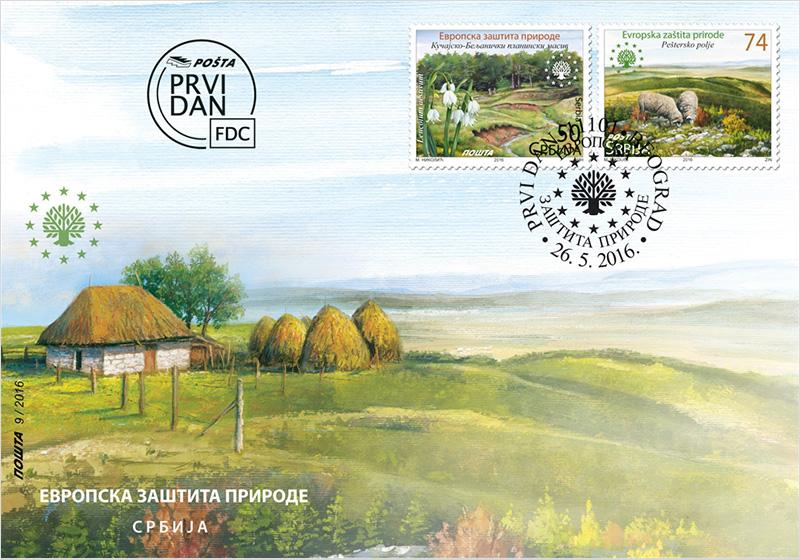

Kučaj-Beljanica mountain massif is the plateau which is intersected by ravines and canyon valleys. Rich water resources are evidenced by more than 30 karst springs, waterfalls, and subterranean rivers. It is the habitat of many rare and endangered plant species, 22 of which are strictly protected, and 31 on the Red List of flora of Serbia. It has also been determined the presence of five species of amphibians, six species of reptiles and about 130 species of birds, thus making it an “Internationally Important Bird Area”. The fauna of mammals includes about 70 species, over 70% of the total mammalian fauna in Serbia. Bats and large mammals are a special value of this area. The area of Kučaj Mountains is part of the international Emerald network, which includes areas of particular relevance in terms of protection and conservation of wild plant and animal species and their habitats. The Institute for Nature Conservation of Serbia has valued Nature park “Kučaj-Beljanica” as natural resource of outstanding significance and the protection category I.
Special Nature Reserve “Peštersko polje” (Pešter field) is one of the largest preserved highland peat bog complexes in the Balkans. Due to the specific climatic, landscape, relief, hydrographic and other conditions, there had been formed a unique complex of marsh, swamp and peat bog habitats in which has been recorded the flora and fauna including numerous protected, rare and endangered species, some of which are found only in Serbia (Bythinella pesterica). According to its significance, Peštersko polje is designated as “Internationally Important Bird Area”, “Internationally Important Plant Area” and a “Prime Butterfly Area”. It has also been included in the “List of Wetlands of International Importance” and the Emerald eco network. Special Nature Reserve “Peštersko polje” is in 2015. declared as protected area of outstanding significance of category I, international and national.
Artistic realization of the stamps: Miroslav Nikolić. Professional cooperators of Institute for Nature Conservation of Serbia: Predrag Lazarević, Dragana Petraš, Nataša Panić and Bojana Bojović.
Games of the XXXI Olympiade – Rio De Janeiro 2016






Since the first Olympic Games of the modern era held in 1896, until today’s XXXI Olympiad, this sports event represents the biggest international sports competition of our times. Under the slogan Citius, altius, fortius – faster, higher, stronger, athletes from all over the world compete to win the brightest medals in their disciplines.
At the first modern Olympic Games in 1896 in Athens, 285 athletes from 13 countries took part competing in 9 sports and 43 sports disciplines, while at the XXXI Olympic Games in Rio de Janeiro participation of about 10,500 athletes who will compete in 28 different sports and 302 sports disciplines is expected.
XXXI Olympic Games which will be held from 5 – 21 August 2016 in Brazil, in Rio de Janeiro are the first Olympic Games in 21st century which are held in the South Hemisphere, in Latin America. Rio de Janeiro was elected host city at the 2009 Congress of the International Olympic Committee in Copenhagen, beating the candidatures of Tokyo, Chicago and Madrid. The mascot of the Games in Rio is Vinicius, named after Vinicius de Moraes, a musician, and represents a mixture of cat, bird and monkey. The design is taken both from pop culture and animated characters of video games.
The opening ceremony of the XXXI Olympic Games is scheduled for 5 August 2016 at Marakana, the famous Brazilian stadium. Most successful athletes will proudly bear flags of 206 olympic committees, and the olympic flag as well, under which independent athletes will compete at the Olympics.
In accordance with tradition, the first flag in the defile of National Olympic Committees and competitors will be the flag of Greece, while the last will be the flag of the host country, the flag of Brazil.
The team of Serbia will be comprised of about 100 athletes who will compete in several team and individual sports disciplines such as basketball, volleyball, water polo, athletics, tennis, rowing, taekwondo…
Expert collaboration: Olympic Committee of SerbiaExpert collaboration: Olympic Committee of Serbia.
Artistic realization of the stamps and the souvenir sheet: MA Nadezda Skocajic, academic painter – graphic artist.
150 Years of the first postage stamp issue in Serbia





The Serbian Post Offices Act came into force on 1st May 1866 and laid foundations for postal stamps issue, introduction of postal items and passengers transport and harmonisation of the postal technology with the European countries, and set forth the introduction of postcards and money orders, as well as the opening of municipal post offices.
The first Serbian postal stamp was issued on 1st May (13th May by the Gregorian Calendar) 1866. That was a newspaper stamp, with the motif of the Coat of Arms of the Principality of Serbia, printed in two nominal values: 1 and 2 paras. The stamp design was made upon proposal of Anastas Jovanović, painter and lithographer, and printing done in the State Printing House (Pravitelystvena knyigopechatnya) in Belgrade. The stamps were delivered to border post offices and pasted onto newspapers (partly pasted on the newspapers and partly on the wrapping, so they had to be torn when the wrapping was removed), and the payment was made by a deposit which the subscribers of foreign newspapers deposited in the post office).
In the same year 1866, on 1st July (13th July by the Gregorian Calendar) the first regular postal stamp with the image of Prince Mihailo Obrenovich III was issued as well. When Anastas Jovanović approved the specimen print, the design, woodprint and printing blocks were made by the Austrian painter and lithographer, Wincenz Katzler. The stamp was printed in the Imperial State Printing House in Vienna, in three colours and three nominal values - of 10, 20 and 40 paras and was used for the collection of taxes on conveyance of letters and postal items.
The Act on Postal Stamps for Letters and Newspapers came into force on 31st October 1866. Printing of the Serbian postal stamps had tremendous significance not only because of the simplification and improvement of postal services but, before all, because of the choice of motifs (the Coat of Arms of the Principality and the image of the monarch), that served to strengthen national identity and enhance state sovereignity.
Artistic realization of the stamp: Jakša Vlahović, academic graphic artist and Radomir Bojanić, academic painter.
Expert collaboration: Ljiljana Đorđević, curator of the PTT Museum in Belgrade.
125 Years Since Tesla’s Transformer Patent
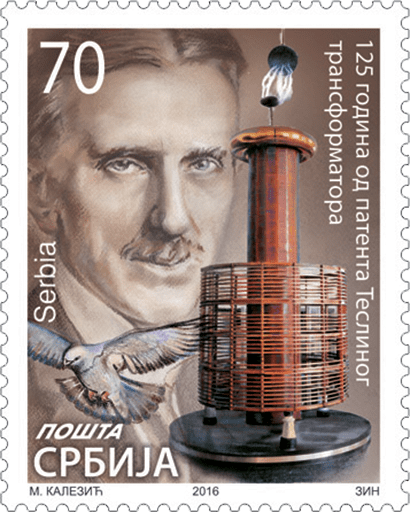




Nikola Tesla (1856-1943), Serbian-American genius scientist, physicist, engineer and inventor, has given humankind a huge number of significant inventions that changed the image of the world around us with the ingenuity of solutions, universality of application and by moving many scientific and technological boundaries.
125 years ago Tesla has realized his famous invention of oscillatory transformer for producing alternating current of high voltage and high frequency. He received the patent for this device in the USA on June 23, 1891 under the number 454.622. Today it is known worldwide as “Tesla’s transformer“, or “Tesla’s Coil”.
Tesla developed different types of this transformer and used them to make and study new physical phenomena, being the first to create continuous high frequency current. Each of the transformers has opened a new chapter in the field of electrical engineering. Tesla used his new devices for testing the physiological functioning of the high frequency currents on the human body, i.e. the possibility of using these currents for medical treatment; lighting in diluted gases; heating of solids in fast-changing magnetic field; transmission of electricity through the non-conducting environment.
However, Tesla has achieved the biggest impact on science and industry by using his oscillator for the production and transmission of radio signals. He was the first to use the monopole antenna (elevated metal body that is grounded at the lower end) in the transmitting section and a similar antenna system in the receiving section, thus creating the basics of long wave radio transmission.
Tesla’s transformer, in its various modifications, has been and still is an indispensable device for testing in the physics laboratories, for creating plasma, fireballs, ball lightning, in accelerators and particle destroyers, in laser technology, radiography, holography.
With the use of modern materials and electronic components, Tesla’s transformer is applied today in various areas of modern industry, medicine and popular culture.
Artistic realization of the stamp: MA Marina Kalezić, academic painter.
Expert collaboration: Nikola Tesla Museum Belgrade.
23rd International Congress of Byzantine Studies – Belgrade 2016







The capital of Serbia will host, from 22nd until 27th of August this year, for the second time, the most eminent scientists and researchers who deal with the history of Byzantium in all its aspects. The first time was in 1927, when the Second World Congress of Byzantologists was held in Belgrade. The Congress, with the help of the International Association of Byzantine Studies, is organized by the Serbian National Committee led by the academician Ljubomir Maksimović.
Georgije Aleksandrovič Ostrogorski (1902, Saint Petersburg – 1976, Belgrade), is one of the founders of Modern Byzantology in Serbia and worldwide, and a writer of the unexcelled synthesis on a thousand years history of Byzantium. He left his country in the midst of the October Revolution and continued his studies in Heidelberg and Paris. He comes to the Chair for Byzanto-logy of the Belgrade University in 1933 and teaches there until his retirement in 1973. He became a member of the SASA in 1946. He founded the Institute for Byzantine Studies at the Serbian Academy of Sciences and Arts (SASA) in 1948, whose director he was until death. With the help of his associates, he organized the 12th International Congress of Byzantologists, which was held in 1961 in Ohrid.
Sava, the first Serbian archbishop (Mileševa monastery, before 1227). The oldest portrait of Sava was painted in his lifetime. He was painted beside his father, Saint Simeon, on the north part of the east wall of the old narthex, and in front of his elder brother, Stefan the First-crowned and the two of his sons - Radoslav and Vladislav. After he consolidated the independence of the Serbian Church during the 3rd decade of the 13th century, Sava pilgrimaged twice the holy places of the East, near the end of his life, in 1229 and 1234/5. On his way back from the second journey, he dies in early 1236 in the Bulgarian capital Trnovo.
Mother of God of Sokolica (around 1315). A marble sculpture of the Mother of God on a throne with the little Christ in Her lap, is the biggest shrine of Sokolica monastery near Zvečan. In the beginning, it adorned a lunette of the western entrance of the temple of Saint Stefan the Archdeacon and Protomartyr in Banjska. The church was built on the model of Studenica, with facades of multi-coloured marble and rich plastic decoration in which, for the last time in the Serbian medieval art, a particular blend of the Byzantine and Romanic art was achieved. The founder, King Milutun, prepared a tomb for himself within the church and was buried there. Of the former iconography, whose gold background is praised by the later chroniclers, only the fragments remain today.
The initial “V” (the second half of the 14th century). A skillful miniaturist created a letter V from an eagle and a lion who attack a rabbit. The initial is in the manuscript with sermons of Isaac Sirin, on a verso 200 sheet. The manuscript is still kept today in the collection of the Museum of the Serbian Orthodox Church in Belgrade.
Mother of God from the Annunciation (Mileševa monastery, before 1227). The monastery with a church which is dedicated to the Ascension of Our Lord Jesus Christ, is the endowment of the younger son of Stefan the First-crowned, Vladislav. The founder, being the Serbian king, translated the relics of his uncle, Saint Sava, from the Bulgarian capital Trnovo, where the first archbishop of the Serbian Orthodox Church passed away in 1236. The frescos of Mileševa represent the highest achievements in the European painting of their time. The monastery was the second in rank in the Middle Ages among Serbian monasteries, right after Studenica monastery.
Gračanica monastery (around 1315). The five-dome Church of the Annunciation is one of the masterpieces of the Serbian medieval art. It was built and decorated inside with iconography with the resources of the King Stefan Uroš II Milutin and it was the seat of the bishops of Lipljan. The emphasized verticality makes it different from the architecural achievements of that time and makes it unique not only in the Serbian medieval architecture, but also in the Byzantine world, where it belongs according to the way of building. In the interior of the church, one of the most extensive painting programmes was preserved. It has its closests parallels, according to the style characteristics, in the best achievements of fresco painting of the Palaeologus age.
The sarcophagus of Saint Stefan Dečanski (a detail, 1343). Surely, the most valuable piece of the Serbian medieval carving, precisely dated and very well preserved. After 12 years of Stefan Dečanski’s death, his incorrupt relics were taken out from the sepulchre under a bigger sarcophagus in the southwest part of the nave of Dečani and it was laid in a new wooden sarcophagus. This happened in the spring or summer of 1343, and since then his relics have been available for the veneration of believers. The basic motif is a herbal brier turned into a geometrical interweaving, with the emphasized polychrome of the entire sarcophagus. The middle fields of the longer sides are additionally ornamented with two pairs of adorned red and green lions.
Emperor Uroš and King Vukašin (Psača monastery, 1366-1371). In Saint Nicholas church, which was built by the father and son, Prince Paskač and Sebastocrator Vlatko, near Kriva Palanka on the territory of today’s Macedonia, the ruler – the last of the Nemanjić dinasty in the Serbian territories, Dušan’s son and the second Serbian emperor, Uroš, and his coruler – the most influential grandee at his court, Vukašin, whom Uroš declared coruler and crowned him king, are represented together. Both of them ended their lives in 1371 – Vukašin died in the battle against the Turks on the river Marica on September 26th, and Uroš died a few months later.
Kalenić monastery (around 1420). This monastery, dedicated to the Entry of the Mother of God into the Temple, in Levač, is the last pearl of the Serbian medieval construction and painting. The founder was the protovestiarios Bogdan, in charge of the state treasury in the last decade of the reign of Despot Stefan. Picturesque facades of this small church of a triconchal basis represent the peak of the final and at the same time the most original phase in the Serbian medieval architecture which developed in the age of Prince Lazar and his son Despot Stefan. The frescos in the temple are characterized by the refinement of pastel colours and the sublimity of the characters who are freed from the then dramatic everyday life which was overcast by the necessity of the Turkish conquest.
Expert collaboration: The Institute for Byzantine Studies, Serbian Academy of Sciences and Arts, Belgrade.
Artistic realization of the booklet: MA Marina Kalezić, academic painter and MA Nadežda Skočajić, academic painter – graphic artist.
50th Anniversary of BITEF








Established in 1967, on the initiative of Mira Trailović and Jovan Ćirilov, BITEF (Belgrade International Theatre Festival) has incessantly followed and supported newest theatre tendencies.
In the five decades of its existence, Bitef has overcome all political and cultural problems and has successfully kept pace with a tumultuous evolution of the theatre art. Because of this fact, the history of Bitef can be called a history of the contemporary theatre.
In the revolutionary 1960s and 1970s spectators had the chance to see some of the boldest scenic experiments which led to the devastation of the forms of drama, but also some important classical pieces and traditional Oriental theatre shows. In the 1980s and 1990s, Bitef reached the highest peaks of the postmodern theatre and dance. Even at the time of political and economic crisis and embargo, Bitef succeeded in promoting highest cultural values bringing to Belgrade some of the greatest names of the world performing scene. In the 2000s Bitef presented new and innovative achievements of the world “mainstream”, the shows of the postdrama and non-verbal theatrical expressions, as well as those realized with the help of new technologies, opening the door to virtual reality of a cyber theatre.
In all these years, Bitef has preserved its place in the family of the most important world festivals. In 1999, the European foundation “Premio Europa per il Teatro“ awarded Bitef a Special Prize for continuity and quality of its endeavours.
Artistic realization of the stamps: Boban Savić, MA, academic painter.
Expert collaboration: Bitef Theatre.
Centenary of the Battle of Kaymakchalan




Kaymakchalan is one of the peaks of a large mountain range called Nidze. This mountain is in the far south of FYR of Macedonia, the then Kingdom of Serbia and it practically represents the border with Greece. It is at an altitude of 2,525 meters, hence the name “Ridge 2525“. On the very top, there is a monumental complex built by the order of the king Alexander I Karađorđević, with a small church dedicated to St. Ilija, which is at the same time a memorial chapel dedicated to the soldiers perished in the Battle of Kaymakchalan. Built in a nontraditional Christian spirit, this building resembles towers from the Gothic period.
The Battle of Kaymakchalan is considered to be one of the greatest battles of the Serbian Army in the First World War. It lasted from 12th to 30th September 1916. Conflicts occurred between the units of the First Serbian Army led by General Petar Bojović and excellently fortified units of the Bulgarian Army.
By liberating Kaymakchalan, the Serbian Army stepped on the territory of its fatherland, again, after almost a year. In these bloody battles, the Serbian Army lost almost 4,500 people, of which Drinska division only, had 3,804 soldiers and officers who were put out of action. The commander of the Volunteer Regiment, major Vojin Popović – Duke Vuk, heroically died at the very doortsep of the fatherland.
The position at Kaymakchalan made it possible for the Serbian First Army and Allied troops to prolong the operations which resulted in the final liberation of the city of Bitola. This victory regained soldiers’ self-confidence and gave them hope in the final victory.
Motif on the stamp: Below the Ploče at Kaymakchalan, 105 mm cannon, Drina Division in action, аrtillery battery commander Captain Garalović (with beard) – photo by the military priest Risto Šuković. Motif on the envelope: Photos of the Serbian military actions in Kaymakchalan in the year of 1916, by authors Risto Šuković and Dragoljub Pavlović, among which is a photo of the Regent Aleksandar observing Bulgarian positions at Kaymakchalan from an observation post on Chegan mountain, at the Ridge1500, accompanied by the Commander of the Army General Pavle Jurišić Šturm, Commander of the Drina Division Colonel Krsta Smiljanić, and other officers.
Expert collaboration: Ministry of Defence of the Republic of Serbia, Department for tradition, standard and veterans.
Graphic realization of the stamp: Nadežda Skočajić, graduated graphic artist.
75 years since the establishment of the Republic of Užice




In late September and early October 1941, on the territory of Western Serbia, Šumadija, and Pomoravlje, a larger free territory was created, as a base for the spreading of the Uprising. Much of the territory was liberated by Partisan and Chetnik units, independently or in conjunction. On this territory, called the Republic of Užice, lived close to one million inhabitants. This was the first major free territory in occupied Europe in 1941. During October and November 1941, Užice became the the Supreme Headquarters of NOPOJ, CK KPJ, and General Headquarters of NOPO Serbia and CK SKOJ. On the liberated territory, production was restored at the Užice Arms and Ammunition Factory, weaving mill, hydropower plants, fireroom, wagon house, leather works, printing shops and other workshops. Health service and railway traffic were organized and vibrant cultural life was blooming. Partisans printed the following newspapers in Užice: Vesti, Borba, Omladinska borba, Bilten Vrhovnog štaba; Novosti in Čačak, and Reč naroda in Gornji Milanovac. In the Partisan unit of Užice an artistic troop was formed within which drama, painting and music section worked. The members of the art studio were: Dragoljub Vuksanović, Pivo Karamatijević, Bora Baruh, Jurica Ribar. Although Partisans and Chetniks negotiated several times during the autumn, their meetings did not contributed to the establishment of a firmer cooperation, and the conflicts and weakening of the resistence forces actually helped the Germans who began the offensive on the free territories on 25 November 1941, moving at the directions Valjevo – Užice and Kraljevo – Čačak – Užice, progressing rapidly. In the evening of 28 November, the Workers’ Batallion was sent towards Kadinjača, in front of the West A battle group. The Germans, being far more numerous, technically more equipped and well – trained, rapidly broke the resistence of the enemy. They broke out on the reef of Kadinjača and closed the hoop around the Workers’ Batallion in pincer movements. On 1 December, German 342nd division with three pursuit groups broke out to the Požega – Uvac – Vardište line, a demarcation line with the Italians, which was actually the end of the German offensive. After the end of the offensive on Partisan units, the Germans attacked the headquarters of Dragoljub Mihailović at Ravna Gora, and about 1500 – 2000 Partisans from western Serbia and Šumadija retreated, together with the Supreme Headquarters, to Sandžak.
Motif on the stamp: Combatants from Kadinjača, (oil on canvas, 1970, Dragoljub Vuksanović). In the background is monument on Kadinjača. Motif on the envelope: monument on Kadinjača (detail) and pencil drawing by Dragoljub Vuksanović Battle.
Expert collaboration: Radivoje Papić, Museum advisor – historian, National Museum of Užice.
Graphic realization of the stamp: Nadežda Skočajić, graduated graphic artist.
Joy of Europe



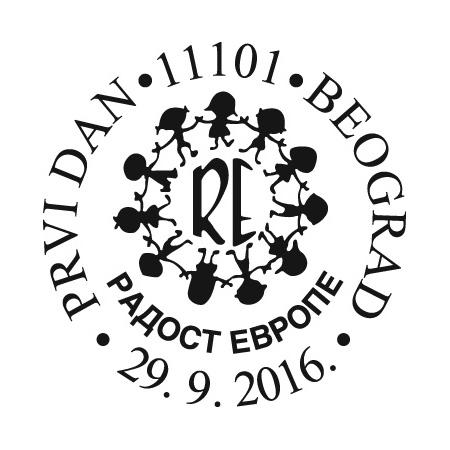
“Joy of Europe” is the biggest and the oldest international event of children’s creativity, organised ever since 1969 on the occasion of the Children’s Day. Every year at the beginning of October the children from a range of European countries come to Belgrade to dance, sing, act, display their works of art, but first of all, make friends and have a good time. There is almost no European country whose children have not been here as a guest at this 46-year long event “Joy of Europe”.
A part of “Joy of Europe” since 1998 has been the international art competition under the same name, with the topic always being “The Dictionary of Friendship”. A great writer and children’s friend Duško Radović put together fifteen universal symbols (child, Europe, bread, play, book, love, mother, peace, father, song, friend, bird, joy, freedom, sun) connecting children all around the world by dancing, singing and finally by image.
For the eighteenth time since its foundation, the exhibition of the International Art Competition presents the most successful works of young artists from Serbia and abroad who with their colourful palette of artwork make the international event Joy of Europe even more beautiful. Every year, the prized works evidence the authenticity of visual culture of childhood, developing sensibility of both the audience and the professional public for this form of artistic expression. At the contest, the children works are divided into five categories for children between four and eighteen. Over the time, the contest expanded much beyond the boundaries of Europe, bringing together children and youth from the entire world. The best works find their place also on the special issue stamp “Joy of Europe”.
Motif on the stamp: drawing by Katarina Kovačević (11 years, Serbia).
Motif on vignette: drawing by Nicole Adamyk (7 years, Slovakia).
Motif on the envelope: drawing by Nemanja Leontijević (11 years, Serbia).
Expert collaboration: Lidija Seničar, editor of drawing and painting competition, Children’s cultural centre Belgrade.
Graphic realization of the stamp: Jakša Vlahović, academic graphic artist.
Stamp Day
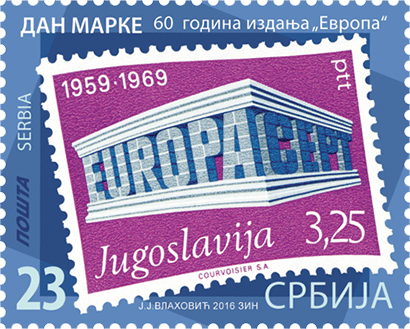





Commemorative postage stamps with the theme Europa are among the most popular in the world. The first stamp of this edition was published on September 15th 1956, and its author, Frenchman, Daniel Gonzague, symbolically depicted the creation of a new Europe, devastated by a World War, as a tower on which vertical letters EUROPA were written. Scaffolding around the tower symbolizes the construction of a new Europe. The stamp was published in 1956 by six countries – Belgium, France, Germany, Italy, Luxembourg, and the Netherlands. Yugoslavia, the first country of the former communist bloc which joined the publishing of the commemorative edition of EUROPA, issued its first EUROPA stamp in 1969, for the ten-year anniversary of the European Conference of Postal and Telecommunications administrations – CEPT, and the admission of the former Community of Yugoslav PTT to this organization.
The draft of the stamp depicts an architectural structure where the letters “Europa – CEPT” make up its main element, colonnade, and it is a work of Andreja Milenković according to the design by Italians, Luigi Gasbara and Giorgio Belli. From 1957 to 1974, all EUROPA stamps had the same visual identity; however, since 1974 CEPT would only suggest a theme, while postal administrations would create individual artistic realizations. In 1984, on the occasion of 25 years of CEPT, all countries published a stamp that had a common design. PostEurop assumed the responsibility for the issuance of EUROPA stamps in 1993, again with a common theme for all member states. In 2000, 57 countries published a stamp of the same design – six stars in a tower. This year also, to mark 60 years since the first edition of EUROPA stamp, all members of PostEurop announced the stamp with the design by Doxia Sergidou from Cyprus. Since 2002, PostEurop has organized “EUROPA Stamp Contest”. Our commemorative stamp with the theme “National musical instruments”, by the author Nadežda Skočajić, stamp designer of the Post of Serbia, was voted the best design EUROPA stamp for 2014. With this year’s “Stamp Day” issue, Post of Serbia is once again marking 60 years since the first EUROPA issue, by publishing two stamps dedicated to this jubilee.
Motif on the stamp face value 23.00 dinars: our first “Europa CEPT” issue from 1969, a draft by A. Milenković.
Motif on the stamp face value 70.00 dinars: 1978 edition “Europa CEPT”, with the theme “Monuments – Golubac, a medieval town on the Danube” by A. Milenković.
Graphic realization of the stamps: MA Jakša Vlahović, academic graphic artist.
Christmas



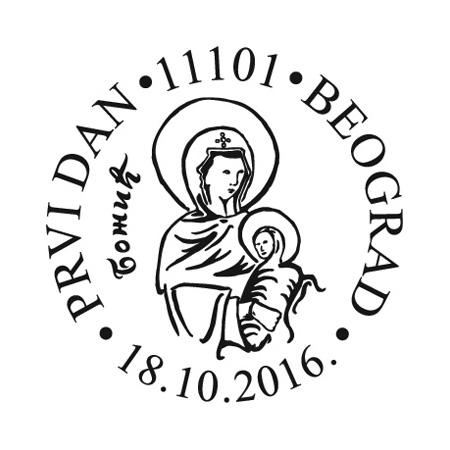
The Christian world celebrates the Nativity of Jesus on December 25th, however three Orthodox Patriarchies – Jerusalem, Russian, and Serbian count time according to the Julian Calendar, and, due to the difference of 13 days, they celebrate the same holiday on January 7th. Christmas is one of the most important and most joyous Christian holidays, and its message is the one of peace and love. Here, we celebrate Christmas for three days. On the day before Christmas, Christmas Eve, Oak branches are being carried inside the home, the sanctuary lamp is being lit, straw spread, and sweets, dried fruit, and coins placed around the home. Straw symbolizes the manger where Jesus was born. Oak branch is a symbol of longevity, strength, and endurance of Christianity, as well as the warmth of love that Christ brought with his birth. On Christmas day, early in the morning, church bells are ringing and announcing the birth of Jesus. People go to church to attend the Christmas liturgy and greet each other with “Christ is born” - “Indeed he is born”.
On stamps and envelops, details of “The Nativity” fresco from the Gradac Monastery are portrayed. Annunciation monastery in the valley of the Ibar River is the endowment of Queen Helen of Anjou, wife of the Serbian King Uroš I. The monastic complex was completed around the year of 1276. The church was built out of cut stone with significant characteristics of Raška stylistic group. Fresco, preserved only in fragments, is one of the most valuable works of Serbian medieval heritage. The compositions on the walls exude monumentality, and among them “The Nativity” fresco stands out, with its narrative account and central motif of Virgin Mary with infant Jesus surrounded by the following scenes: the announcement to the shepherds, bathing of the new-born Christ, the adoration of the shepherds, arrival and return of the three Wise Men, Joseph’s dream, the escape to Egypt, testing of faith, reception of the sages, and the Massacre of the Innocents in Bethlehem. The monastic complex was reconstructed, and the fresco was preserved during the period 1962 -1973. After the construction of a new lodging in 1990, the spiritual life of the monastery was renewed.
Motifs on stamps and envelopes: “Nativity of Jesus”, details of the fresco from the Gradac Monastery, end of the 13th century.
Expert collaboration: Serbian Orthodox Church, Eparchy of Žiča.
Graphic realization of the stamps: Nadežda Skočajić, graduated graphic artist.
Remembering the victims of the Second World War - Kragujevac 1941.



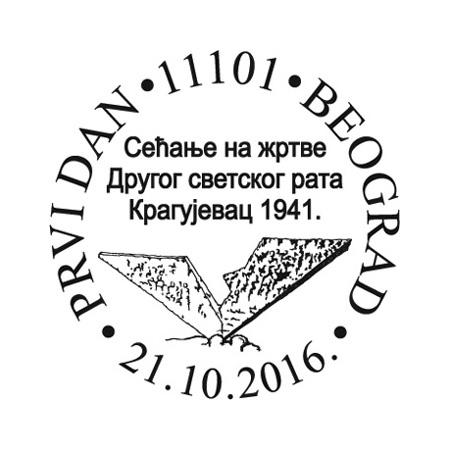
The execution in Kragujevac on 21 October 1941 is one of the greatest atrocities of the German Army in the WWII. In the reprisal action, in a single day and within seven hours only, the Nazis killed several thousands of men, women and children. The reason for executions were the German losses of 16 October 1941, when in the clashes with Partisans and Chetniks in the vicinity of Kragujevac 10 German soldiers were killed and 26 wounded. The reprisals started on 19 October in the villages of Maršić, Mečkovac (Ilićevo) and Grošnica, where a hundred hostages were shot for every killed German soldier, and fifty for every wounded. The villages, as the Nazis used to say, were broods of bandits. According to the information gathered so far, 415 people were killed that day, while 21 managed to survive. Already on 20 October, several thousands of citizens of Kragujevac were arrested and imprisoned in the cannon sheds in the suburbs of the city; among them also a several hundreds of students of the Kragujevac secondary schools. In the evening, around 6 p.m, a special group of 123 people was brought out for killing – inmates from the Kragujevac prison, communists, nationalists and Jews. It was just an introduction into the tragedy which would start on 21 October at 7 a.m. Torrents of people were flowing from the cannon sheds, led by the Germans for killing. Everything was over by 2 p.m. In the valleys of Erdoglijski and Sušica streams several hundred people lay dead, among them three hundred young men and students of secondary schools and 23 teenagers between 12 and 15, mainly Roma shoe cleaners from Kragujevac.
Through decades of research, the information on 2,264 executed persons and 31 survivors were collected at the Museum of 21 October. Major Paul Kenig, in charge of the executions, surpassed in cruelty even the monstrous order of the General Franz Böhme – A hundred for one, in accordance with which 2,300 people should have been killed as a retribution for German losses. Within three days, 2,854 persons were led before the firing squad. By a twist of fate, 62 persons survived. After the war, the execution grounds were made into a memorial compound dedicated to the victims of this atrocity, and the museum constructed at the compound entrance in 1976. The Monument to Killed Students and Teachers has become a symbol of the tragedy and the City of Kragujevac itself.
Motif on the stamp: Monument of Pain and Defiance, by Ante Gržetić, 1959. Motif on the vignette and envelope: The Monument to Killed Students and Teachers, by Miodrag Živković, 1963. In the background of the stamp and envelope is shown the text of Proclamation by which the German local Kommandatur of Kragujevac announced the shooting of citizens of Kragujevac in October 1941.
Expert collaboration: Jelena Davidović, Museum Advisor, Memorial Park Kragujevac October.
Graphic realization of the stamp: Nadežda Skočajić, graduated graphic artist.
Museum Exibits








Stecci
Stećci, stećak (sing.) or stećci (pl.) are medieval monolithic tombstones found on almost all the territory of Bosnia and Herzegovina, in the western parts of Serbia and Montenegro and in central and southern parts of Croatia. It is assumed they first appeared in the second half of the 12th century. They were most intensively hewed in the 14thand 15th century before gradually ceasing to be made in the 16th century. The systematic inventory resulted in the figure of around 70 000 registered tombstones at about 3300 sites on the territory of the mentioned states.
Stećci were mostly made of limestone – a most common type of stone in this region very suitable for carving. Quarries for quarrying stone for stećci were mainly located in the vicinity of cemeteries bearing in mind that those were stone blocks of up to several tons.
According to the shapes of stećci they are divided into five basic types with variations: slab, chest, sljemenjak (gabled roof stećak), monumental cross and pillar. Decorative motifs may be divided into several groups: social and religious symbols (different types of crosses, tools, weapons, new moon and stars, anthropomorphic lilies, solar motifs), figural compositions (images of men and women, animals, jousting scenes, tournaments, hunting, parades of people, so-called funeral wheel-dances) and numerous vegetal and geometric ornaments.
Stećci – Medieval Tombstones Graveyards in Bosnia and Herzegovina, Montenegro, Croatia, and Serbia were inscribed on UNESCO’s World Heritage List on July 15, 2016. The Republic of Serbia nominations are archaeological sites, Mramorje, Pеrućac and Mramorje, Rastište, (Bајinа Bаštа Municipality) and the Greek Cemetery in the Hrta Village (Prijepolje Municipality).
Motifs on stamps: face value 23 RSD: Tree of Life, Burđića rast near Krupanj 14th century; face value 46 RSD: Dragon, Mramorje in Lipenović, Krupanj, 14th century; face value 50 RSD: Arcades, the Greek Cemetery in the Hrta Village, Prijepolje Municipality, 14th to 15th century. Motif on the envelope: Tree of Life, Mramorje in Lipenović, Krupanj, 14th century.
Expert collaboration: Institute for the Protection of Cultural Monuments of Serbia – Belgrade.
Artistic realization of the stamps: MA Anamari Banjac, academic painter.
Children’s stamp




Жаба чита новине, Ј. Ј. Змај
Седи жаба сама / На листу локвања,
Од жаркога сунца / Штитом се заклања.
Да новине чита, / То вам слика каже,
Ал’ не мож’ да нађе / Штa јој очи траже.
Знате већ о чему / Жабе бригу воде:
Хоће ли се скоро / Одселити роде.
Jovan Jovanović Zmaj (1833 – 1904) was a lyrist of Serbian romanticism, as well as the founder of poetry for children within Serbian poetry. Spontaneously, gently and tenderly, humorously but didactically, Zmaj teaches children, through his poetry, about nature, things, situations in life – good and bad, in an imperce-ptible and unintrusive way. The scope of his lyrics is the entire childhood, from cradle to boyhood, with everything that belongs to the world of children – plays and toys, animals, relationship with grown-ups. In the rich and diverse gallery of his poetic characters there are little Jova, mama’s baby, lazy Gaša, Juca and Steva, as well as a frog, stork, ducklings... Even when they do not have a specific ethical lesson, the poems of Zmaj are joyful, cheerful and creative, just like children’s play.
Zmaj published the first of his poems for children, Gaša, in 1858. Since then, up until his death, he wrote more than 450 poems for children, prompted not only by love towards them, but also by his personal tragedy that befell him – the deaths of his most beloved ones – his wife Ruža and his children, to whom he dedicated his collections of lyrical poems Đulići (Little Rosebuds) and Đulići uveoci (Faded Little Rosebuds). Zmaj also wrote satirical and political poems, and although a physician by profession, he dedicated all his life to editing and publication of literary, political and children’s magazines. He edited a literary journal Javor, satirical newspapers Žiža, Starmali and Komarac (Mosquito), and in 1880, he started and edited until his death, a famous children’s newspaper Neven (Marigold). He also dealt with translations and successfully translated poems of Šandor Petefi, Goethe and Heine.
Verses of the most famous Zmaj’s poems for children such as Mali konjanik (Little Rider), Pačija škola (Ducklings’ School), Taši taši (Clap Clap), Zimska pesma (Winter Poem), Žaba čita novine (A Frog is Reading a Newspaper)... are even today a mandatory and favourite literature among parents and children as well.
Artistic realization of the stamps: Miroslav Nikolić
Art







225 Years Since the Birth of Sima Milutinović Sarajlija
Simeon Milutinović – Sima Sarajlija (October 3, 1791, Sarajevo - December 30, 1847, Belgrade) was a Serbian poet. He studied philosophy in Germany and met prominent German writers (Goethe) which is when he printed his epic poem “Serbijanka”. Upon his return, he became the tutor of Njegoš in Cetinje, and later a customs and police officer, secretary of ministry, and a member of appeal court. He engaged in verse writing , politics, historiography, and linguistics. Some of his other important works are: epic poems “Trojebratstvo i Trojesestarstvo” (“Three Brotherhoods and Three Sisterhoods”); drama from the history of Montenegro “Montenegrin Pride”, tragedy “Obilić”, a collection of lyric poems and two historical writings: “History of Serbia”, which includes only the period 1813-1815, and “History of Montenegro – from ancient to modern times”.
175 Years Since the Birth of Laza Kostić
Laza Kostić (February 12, 1841, Kovilj - November 26, 1910, Vienna) – Serbian writer, poet, journalist, playwright, translator, and aesthetician, one of the most significant writers of Serbian Romanticism. He wrote lyric and epic poetry, ballads, and romances, stories “Fairy Child”, “Maharaja”, “Martyr”, three plays “Maksim Crnojević”, “Pera Segedinac”, “Turncoat’s Dear” or “Gordana”, aesthetic debate “Basics of the beauty in the world with particular regard to Serbian folk poems”, philosophical treatise “Basic Principle – a Critical Introduction to General Philosophy”, and a large monograph “About Jovan Jovanović Zmaj (Zmajovi), his poems, thought, writing, and his era”. Among his most famous work is “Between Reality and Dream” and “Santa Maria della Salute”. It is significant also to mention his translations of Shakespeare’s Hamlet, Romeo and Juliet, and King Richard III.
125 Years Since the Birth of Stanislav Vinaver
Stanislav Vinaver (1st March 1891, Šabac – 1st August 1955, Niška Banja) – Serbian poet and translator, satirist, journalist, man of letters and essayist. He was a member of the group of the new modernistic Serbian writers, as a poet and essayist he founded the Expressionist movement; he wrote Manifesto of Expressionism, as well as the most famous works: a collection of symbolic poetry Mjeća, Stories that Lost Their Balance, Thoughts, Evil Wizards’ Small Town, Lightning Rod of the Universe, Keepers of the World, Icarus Flight, Comrades of War, European Night, Our Daily Language, Ecstasies and Spites of Laza Kostić. Vinaver was the first one to translate Hašek’s The Good Soldier Švejk, Rabelais’s Gargantua and Pantagruel, Carroll’s Alice’s Adventures in Wonderland, Twain’s.
125th Anniversary of Birth of Tin Ujević
Augustin Tin Ujević (5th July 1891, Vrgorac, Austro-Hungary – 12th November 1955, Zagreb, FNRY) – one of the greatest Yugoslav and Croatian poets. A powerful and fruitful creator of original talent, his presence in literature between the First and the Second World War vividly influenced its flow and development; a poet of expressive sensibility and refined taste, critic, essayist and feuilletonist. As a good connoisseur of foreign languages, he translated Proust, Rimbaud, Poe... His most important works are: Wailing of a Slave, Necklace, Two Chief Bogomils: Tolstoy and Gandhi, The Week of the Underaged, Car on the Street, Unhappy Bell, People Behind the Door of the Inn, Scalpel of Chaos, Thirsty Stone at the Well; the most famous poems: A Daily Lament, Necklace, Thought about Her, Tall Poplars, Departure, Forgiveness.
125 Years Since the Birth of Mikhail Bulgakov
Mikhail Afanasyevich Bulgakov (15th May 1891, Kiev – 10th March 1940, Moscow) – Russian writer, playwright and theatre director. He wrote in Russian. The author of great number of novels, short stories, feuilletons, theatre plays, dramatisations, film scripts and opera librettos. The most famous works include novels The Master and Margarita, Life of Monsieur de Molière, Theatrical Novel, The White Guard, The Engineer’s Hoof, plays Days of the Turbins, Flight, The Cabal of the Hypocrites (Molière), Adam and Eve, Batum, Alexander Pushkin (The Last Days), Crazy Jourdain, comedies Zoyka’s Apartment, Ivan Vasilyevich, and the cycle of stories The Steel Windpipe (A Country Doctor’s Notebook).
125 Years Since the Birth of Lajos Zilahy
Lajos Zilahy (27th March 1891, Nagyszalonta, Transylvania – 1st December 1974, Novi Sad) – Hungarian writer and playwright. One of the most prominent, if not the most read Hungarian author of the twentieth century. Several novels of his have been translated into dozen of languages, and the most famous works are: Ararat, Deadly Spring, The Soul Extinguished, Prisoners, Something is Drifting on the Water, Two prisoners, The Deserter, Revenge of Arms, An Angry Angel, Century in Scarlet.
150 Years Since the Birth of Wassily Kandinsky
Wassily Kandinsky (December 16, 1866, Moscow - December 13, 1944, Neuilly-sur-Seine) – Russian painter who possessed a very high artistic intelligence and a keen sense of colour and form. He gave a deeper inner meaning and association to all colours, so he placed them next to their opposites. He founded Der Blaue Reiter (Blue Rider) art group and was the author of a highly influential book “On the Spiritual in Art”. He travelled far with geometric paintings through expressionism, abstraction, and constructivism. Much like in music, he divided his paintings into three categories: Impressions, Improvisations, and Compositions. His work belongs to the artistic movement known today as abstract expressionism (Fugue, A Riding Amazon, Autumn in Murnau, Nina Kandinsky, Autumn in Bavaria, White Line, Improvisation 209, Composition X...)
175 Years Since the Birth of Antonín Dvořák
Antonín Dvořák (September 8, 1841, Nelahozeves - 1 May 1904, Prague) – Czech composer and conductor of Romantic music. He successfully combined folk music with symphonic and chamber music. He created symphonies (most popular of which is the New World Symphony in E-minor), operas (Rusalka, The Jacobin, The Devil and Kate), symphonic poems, poems, overtures, orchestral compositions, chamber music, and concerti – for Violin, for Cello, for Piano and Orchestra, Humoresque, Slavic Dances. Dvořák was a follower of Neo-romanticism and one of the creators of the Czech national school.
Artistic ralization: MA Marina Kalezić, academic painter.
150th anniversary of the birth of dr Vojislav M. Subotić


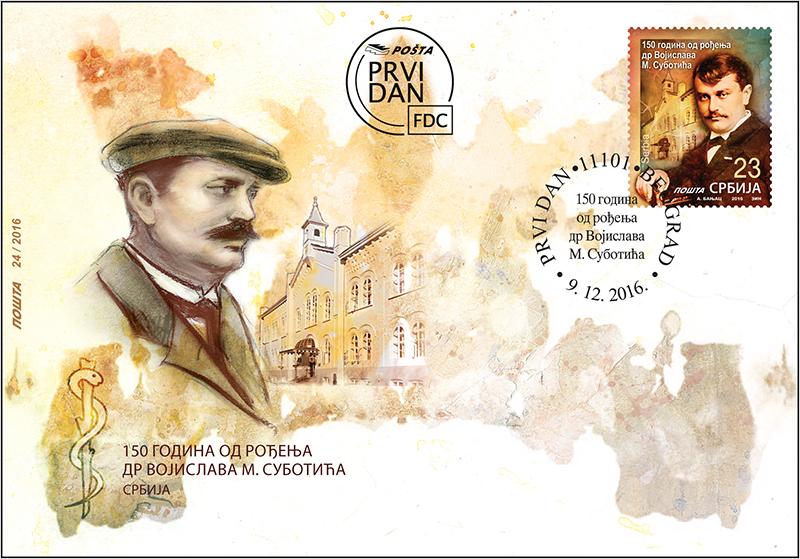

Dr Vojislav M. Subotić junior, neuropsychiatrist, is considered to be the founder of forensic psychiatry in Serbia. He was born on December 24th 1866 in a village Ramaća, near Kragujevac, in the family of priest. He completed secondary education in Kragujevac. In 1866 he went to medical school in Vienna. He specialized in Psychiatry in Vienna and Paris, where in 1894 he passed the specialist exam. At the service of the Hospital for Mental Diseases in Belgrade he came in 1892. In 1907 he became Primarius, and in 1911 he was appointed warden of the Hospital.
He participated in the Serbo-Bulgarian War in 1885, the Balkan wars and the World War I and was promoted to the rank of reserve medical lieutenant colonel; he was a long-time secretary of the Serbian Red Cross. He also was the treasurer, then secretary, and from 1921, the President of the Serbian Medical Society.
In World War I he lost his only son and wife, and he himslef got sick and was taken prisoner in 1915. Untill the end of the war he was engaged at the Hospital for mental illness in Belgrade, and at the same time he was engaged as a representative of the President of the Serbian Red Cross.
Dr Subotic was a great benefactor. All the revenue he gained from the book Dr Vladan Djordjević. 50th Anniversary of Literary Work 1860-1910, that he published in 1910, he donated to the Fund for poor doctors, their widows and orphans, of Serbian Medical Society. Due to the free medical check ups he conducted during the World War I and financial aid to the poor, people called him mother of the poor. In 1915 he founded the Foundation of Medical Student Luka and His Parents Melanija and Dr Vojislav M. Subotić, in which he had invested all his immovable property for the benefit of the poor physicians in Serbia and for the education of war orphans.
He was awarded the Medal of St. Sava of the III degree, Takovo Cross of the IV degree, Medal of White Eagle of the IV degree, The Cross of Mercy, Serbian Red Cross and several Russian medals and decorations of foreign Red Cross Societies. He has published five very significant books and 38 scientific papers in Serbia and abroad. He deceased in Vienna in 1922.
Expert collaboration: Academician Radoje Čolaković, Professor Emeritus, President of the Serbian Medical Society, Belgrade.
Artistic realization: MA Anamari Banjac, academic painter.